Passages en passant
presenteert
Lucie Havel & Dico Kruijsse / Carolin Lange
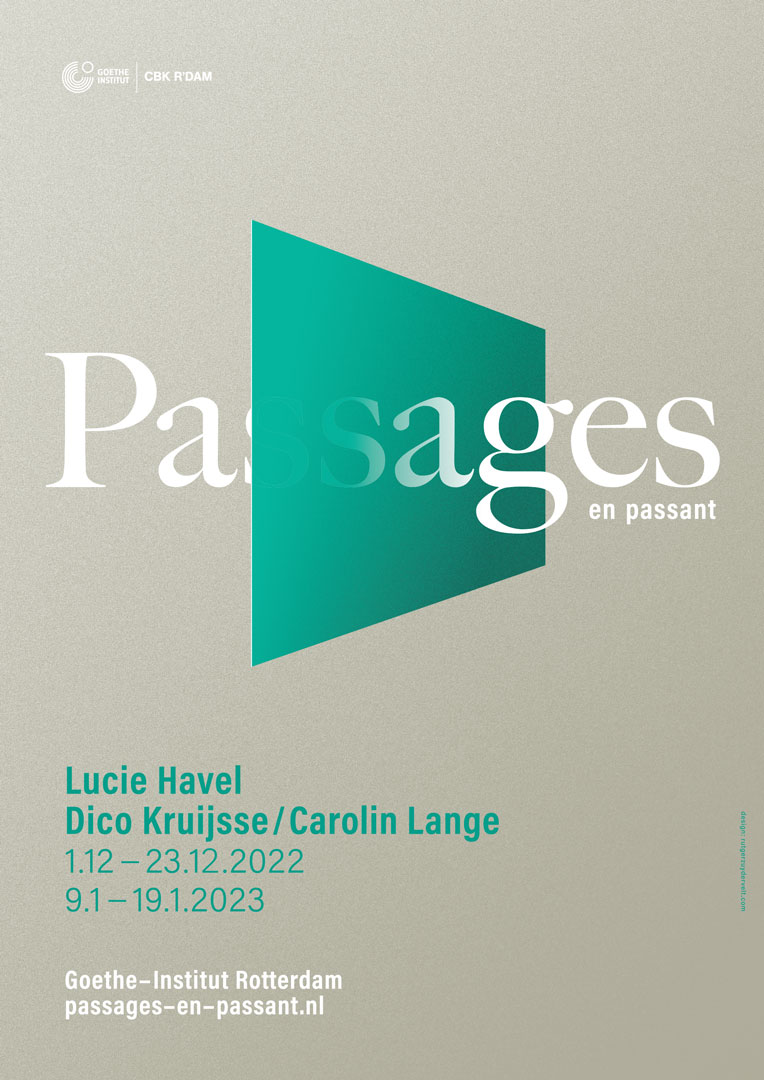
Passages en passant is een reeks tentoonstellingen in de gang van het Goethe-Institut Rotterdam waarbij iedere keer de werken van twee kunstenaars in dialoog met elkaar treden.
Dit format is bedoeld als ruimte voor uitwisseling met en door de werken, aanleiding tot gesprek en als ontmoetingsplek voor geïnteresseerden.
In deze vijfde tentoonstelling tonen wij werk van
Lucie Havel & Dico Kruijsse / Carolin Lange.
De opening van de tentoonstelling is op donderdag 1 december om 17:00
Je bent van harte welkom.
Goethe-Institut Rotterdam
Westersingel 9
3014GM Rotterdam
De tentoonstelling is verlengd tot en met 16 februari!
OPENINGSTIJDEN
9 t/m 13 januari 2023: maandag t/m vrijdag (10:00-14:30 uur)
16 januari t/m 16 februari 2023: maandag, dinsdag, woensdag en donderdag (10:00-21:30 uur) en vrijdag (10:00-14:30 uur)
Click for English
Passages en passant is a series of exhibitions in the corridor of the Goethe-Institut Rotterdam, each time showing the works of two artists in dialogue with each other.
This format is intended as a space for exchange with and through the works, a trigger for conversation and a meeting place for interested people.
In this exhibition, we are showing works by
Lucie Havel & Dico Kruijsse / Carolin Lange.
The opening is on thursday 1 december 17:00
You are warmly invited.
Goethe-Institut Rotterdam
Westersingel 9
3014GM Rotterdam
The exhibition has been extended until 16 February!
OPENING HOURS
9 – 13 january 2023: monday – friday (10:00-14:30 h.)
16 january – 16 february 2023: monday – thursday (10:00-21:30 h.) and friday (10:00-14:30 h.)
Lucie Havel
Lucie Havel focust zich op de relatie tussen natuur en cultuur in de westerse samenleving. Door (wetenschappelijk) onderzoek tracht Havel een alternatief voor deze dualistische visie te vinden. Hiervoor zoekt ze naar transformatieprocessen waarin de identiteit van haar materiaal en onderwerp behouden blijft. Tijdens het project How I fell in love with the Enemy onderzocht Havel de beruchte Japanse duizendknoop. Voor Passages en passant maakte ze een installatie die uit deze reeks voortvloeit.
Lees meer over het werk van Lucie
“Een plant leren kennen is je horizon verbreden.” – Jean Sebastien Poncet
Voor Passages en passant produceerde Havel een installatie vervaardigd uit Japanse duizendknoop. Puttend uit de intrinsieke eigenschappen van deze plant, zoals zijn genetische diversiteit, zoekt Havel naar een nieuwe en minder antropocentrische manier van de ander weergeven.
Met de steun van een Ontwikkeling- en Onderzoekssubsidie van het CBK Rotterdam, begon Havel in 2019 een verdiepingsonderzoek over de Japanse duizendknoop. Het doel van dit onderzoek was om een andere omgang met deze plant vast te stellen, een alternatief voor onze exploiterende houding. Haar idee was dat misinformatie of het gebrek aan informatie een exploiterend systeem mogelijk maken. Daarom heeft ze zich naast het materiaalonderzoek geconcentreerd op de geschiedenis van de plant, de biologie en de relatie met de mens.
Gedurende het anderhalve jaar dat het onderzoek duurde, stond de Japanse duizendknoop centraal in haar leven. De plant werd gegeten, gedronken en met de actieve componenten (de polyfenolen) werd inkt en textielverf in diverse kleuren gemaakt. Uit de structuur van de plant, de vezels, ontstonden karton-achtige materialen, touw en papier. De droge stengels zijn gebruikt voor lichte maar sterke driedimensionale structuren. Dit klinkt misschien als een utilitaire behandeling van de plant, maar elk verkregen materiaal benadrukt eigenlijk een kenmerk ervan. Met andere woorden, elke eigenschap is vertaald naar een materiaal. Alles bij elkaar vormt dit een portret.
Hieruit blijkt dat onder voorwaarde van basiskennis (vooral in biologie en scheikunde) en observaties veel te bereiken valt. Dat beantwoordt ook een andere onderzoeksvraag: In hoeverre kan een Antropoceen-mens zich aanpassen aan zijn omgeving in plaats van andersom?
Lucie Havel focuses on the relationship between nature and culture in Western society. Through (scientific) research, Havel tries to find an alternative to this dualistic view. For this, she looks for transformation processes in which the identity of her material and subject is preserved. During the project ‘How I fell in love with the Enemy’, Havel researched the infamous Japanese knotweed. For Passages, she created an installation that evolved from this series.
Read more about the work of Lucie
“To get to know a plant is to broaden ones horizon.” – Jean Sebastien Poncet
For Passages en passant, Havel produced an installation made of Japanese knotweed. Drawing on the intrinsic properties of this plant, such as its genetic diversity, Havel seeks a new and less anthropocentric way of representing the other.
With the support of a Development and Research Grant from CBK Rotterdam, Havel began an in-depth study of Japanese knotweed in 2019. The goal of this research was to establish a different way of dealing with this plant, an alternative to our exploitative attitude. Her idea was that misinformation or the lack of information enables an exploitative system. Therefore, in addition to material research, she has focused on the history of the plant, its biology and its relationship with humans.
During the year and a half of research, Japanese knotweed was central to her life. The plant was eaten, drunk and its active components (the polyphenols) were used to make ink and textile paint in various colors. From the plant’s structure, the fibers, cardboard-like materials, rope and paper were created. The dry stems were used for light but strong three-dimensional structures. This may sound like a utilitarian handling of the plant, but each material obtained actually highlights a characteristic of it. In other words, each characteristic is translated into a material. Altogether, this forms a portrait.
This shows that under the condition of basic knowledge (especially in biology and chemistry) and observations, much can be achieved. This also answers another research question: to what extent is it possible for an Anthropocene human to adapt to his environment rather than the reverse?
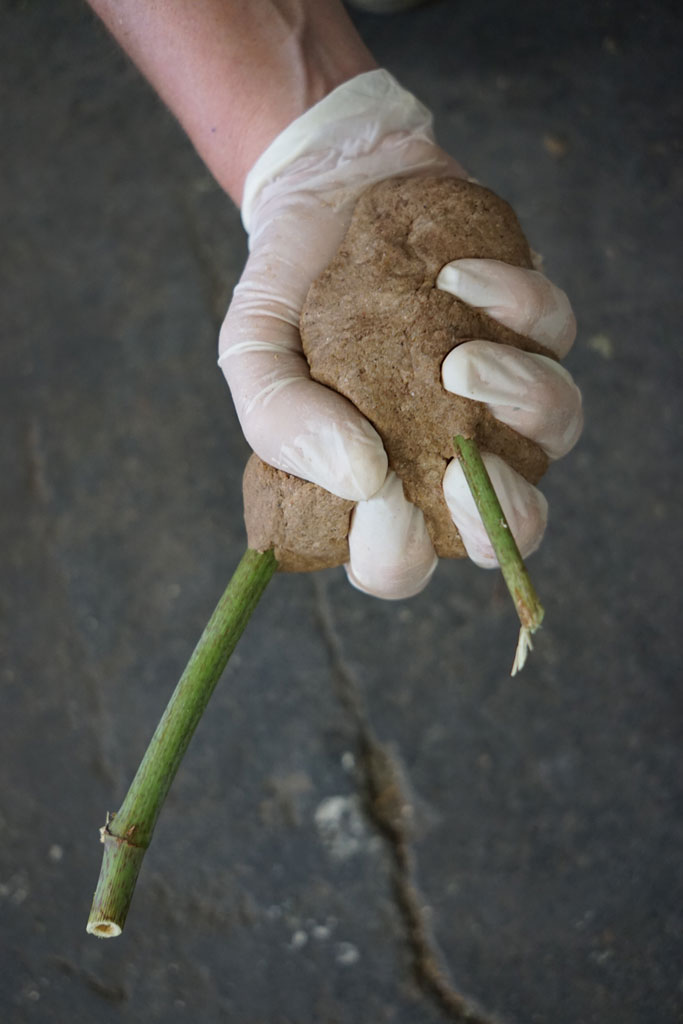
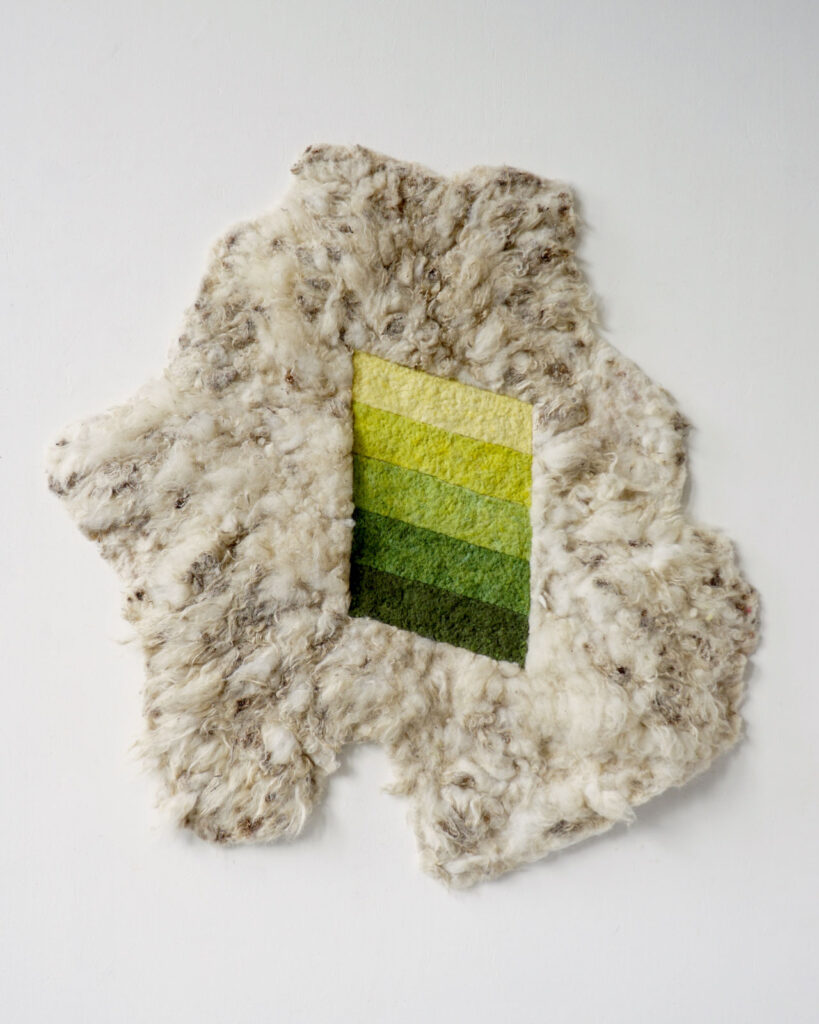
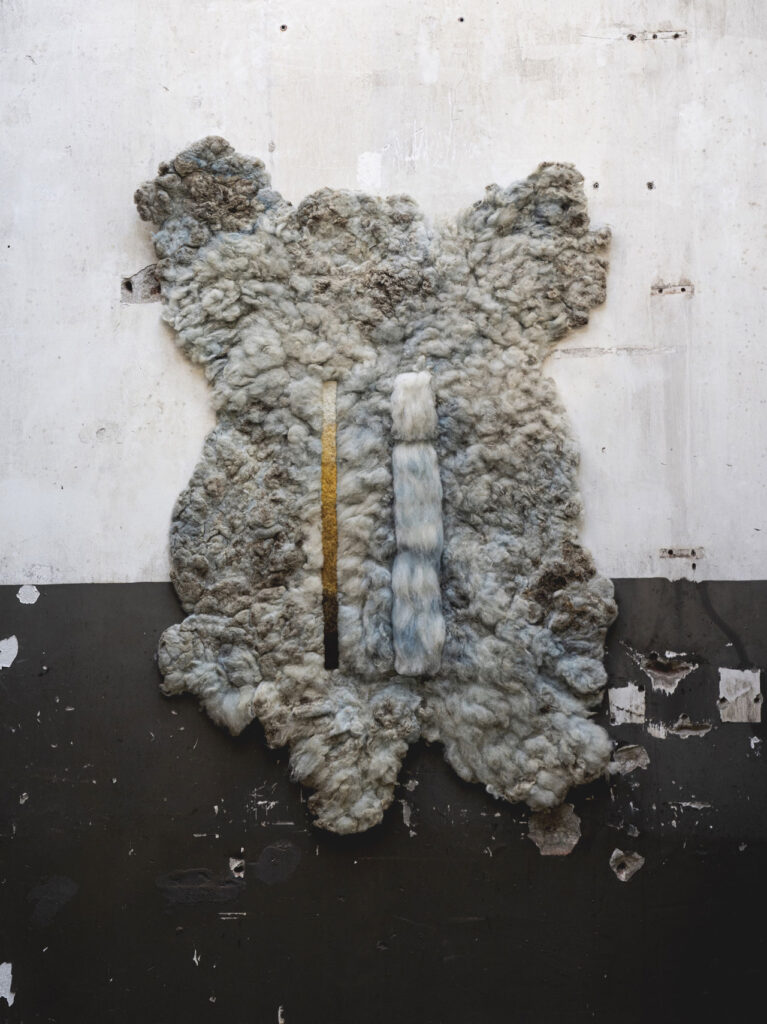
Materiaalonderzoek, Japanse duizendknoop
2021
Toison 2
Scheerwol, indigo, reseda 117/100 cm
2021
Toison 8
Scheerwol, indigo, Japanse duizendknoop 135/95 cm
Foto: Davids Danoss
2021
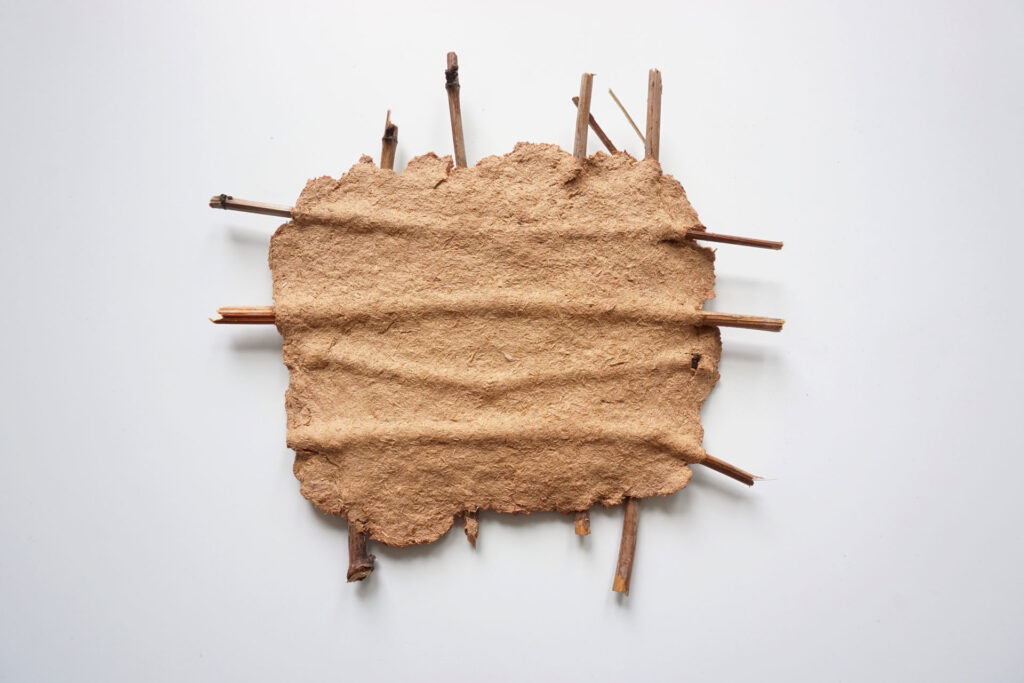
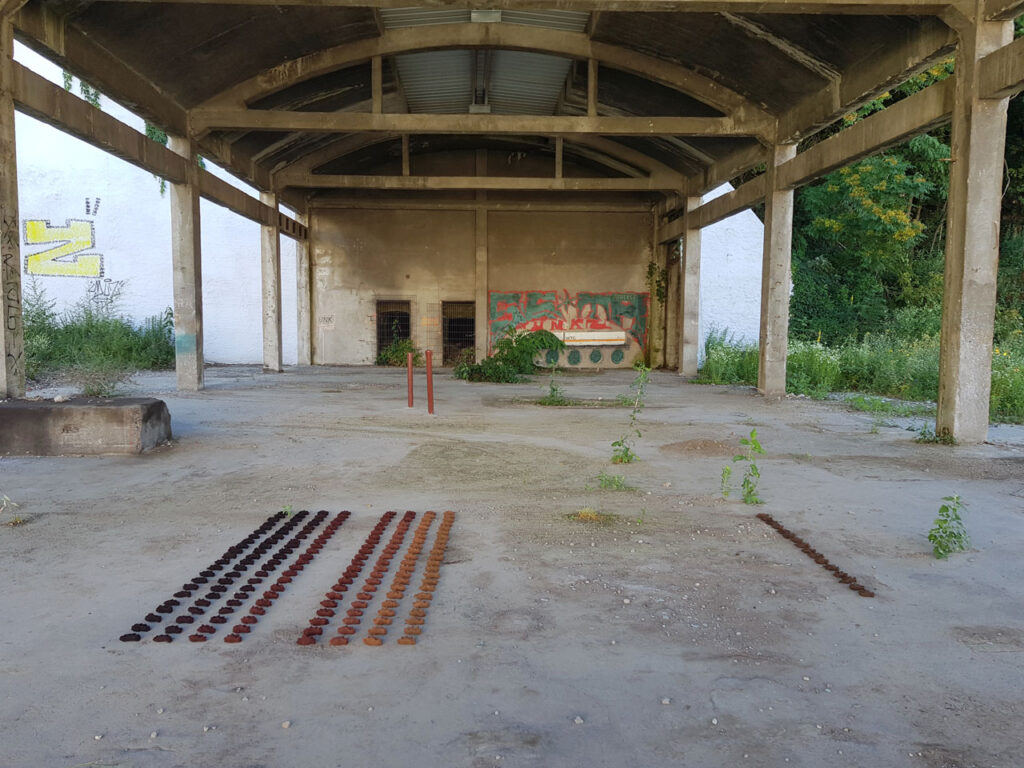
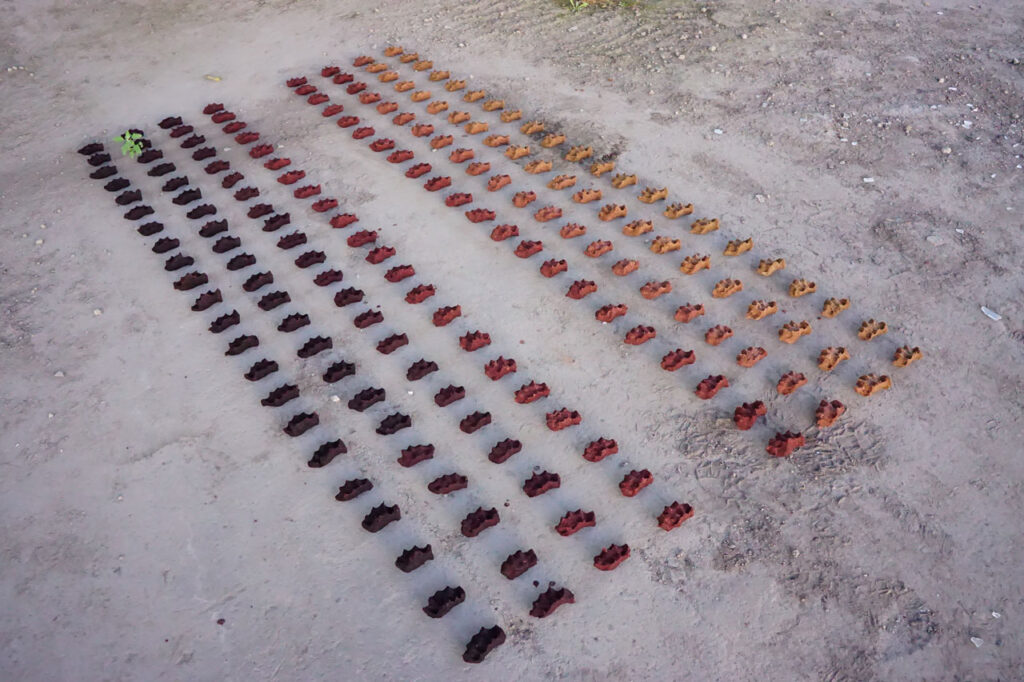
Materiaalonderzoek, Japanse duizendknoop 25/25 cm
2019
Army
Werk in situ, Japanse duizendknoop en andere organisch materiaal 270 / 210 cm St Etienne France
Army
Werk in situ, Japanse duizendknoop en andere organisch materiaal 270 / 210 cm St Etienne France (detail)
Dico Kruijsse / Carolin Lange
Dico Kruijsse en Carolin Lange werken samen aan het project Under The Same Sun dat de relatie onderzoekt tussen zonlicht, de perceptie van tijd en architectonische ruimtes. Ze beschouwen een gebouw als een ‘camera’ waarin ze lichtsituaties op locatie en binnen nieuw gecreëerde werkmodellen van een architectuur vastleggen. Met het monochroom-blauwe fotografische proces, de cyanotype, creëren zij abstracte fotogrammen van licht en schaduw binnenin gebouwen en modellen.
Lees meer over het werk van Dico en Carolin
Dico Kruijsse en Carolin Lange werken samen aan het project ‘Under the same Sun’. Het project onderzoekt de relatie tussen zonlicht, de perceptie van tijd en architectonische ruimtes. Ze gebruiken een gebouw als een ‘camera’, als een analoog opnameapparaat. Op locatie en binnen nieuw gecreëerde werkmodellen worden lichtsituaties fotografisch vastgelegd. Met de cyanotypie, een fotografisch proces, creëren ze abstracte fotogrammen van licht en schaduw in gebouwen en modellen. Lange en multiple belichtingstijden maken ruimtelijke relaties en de rotatie van de aarde om de zon zichtbar.
De cyanotypie werd ontdekt in de begindagen van de fotografie en in de wetenschappelijke studies naar de eigenschappen van licht. In de jaren 1880, veertig jaar na de ontdekking, zorgde het als het blauwdruk proces voor een revolutie in de architectuurpraktijk door de eerste blauwe kopieën van bouwtekeningen te produceren. ‘Under the Same Sun’ neemt beide oorsprongsverhalen, het vastleggen van licht en van ruimte, als uitgangspunt om te onderzoeken hoe we locaties en tijd door zonlicht ervaren.
Elke lichtopname legt een bepaald moment vast, waardoor elke cyanotypie uniek is. De abstracte beelden van licht en schaduwen zijn ook universeel en verbinden verschillende gebouwen met elkaar. Door het diepblauwe en lichtstabiele pigment van het medium worden verschillende intensiteiten van blauw en kleurdiepte bereikt. Het pigment werkt aan de rand van het zichtbare spectrum. Afhankelijk van de lichtbron verschijnt een cyanotypie anders voor het oog. Verschillende belichtingstijden en instellingen creëren zo een ervaring van tijd en ruimtelijke relaties binnen de blauwe opnames van het licht.
Carolin Lange https://carolinlange.com/
Dico Kruijsse https://dicokruijsse.hotglue.me/
Dico Kruijsse and Carolin Lange work in collaboration on the project ‘Under the same Sun’ that investigates the relation between sunlight, the perception of time and architectural spaces. They regard a building as a ‘camera’ in which they record light situations on site and within newly created working models of an architecture. With the monochrome-blue photographic process, the cyanotype, they create abstract photograms of light and shadow inside buildings and models.
Read more about the work of Dico and Carolin
Dico Kruijsse and Carolin Lange collaborate on the project ‘Under the same Sun’, which explores the relationship between sunlight, the perception of time and architectural spaces. They understand a building as a ‘camera’,as an analogue recording device. They capture light situations on location and within newly created working models of an architecture. Using the monochrome-blue photographic process, the cyanotype, they create abstract photograms of light and shadow inside buildings and models. Long and multiple exposure times reveal spatial relationships and the earth’s rotation around the sun.
The cyanotype was discovered in the early days of photography within a scientific context to study the properties of light. In the 1880s, forty years after its discovery, it revolutionised architectural practice by producing the first blue copies of architectural drawings: The Blueprint. ‘Under the Same Sun’ takes both origin stories, capturing light and copying architectural spaces, as a starting point to explore how we experience locations and time through sunlight.
Each light capture captures a specific moment, making each cyanotype unique. The abstract images of light and shadows are also universal, connecting different locations. The deep blue and light-stable pigment of the medium obtains different intensities of blue and of depths and operates at the edge of the visible spectrum. Depending on the light source, a cyanotype appears differently to the eye. ‘Under the same sun,’ is interested in these perceptual qualities of the pigment, and how different exposure times and settings create an experience of time and spatial relationships within the monochromatic blue recordings of light.
Carolin Lange https://carolinlange.com/
Dico Kruijsse https://dicokruijsse.hotglue.me/
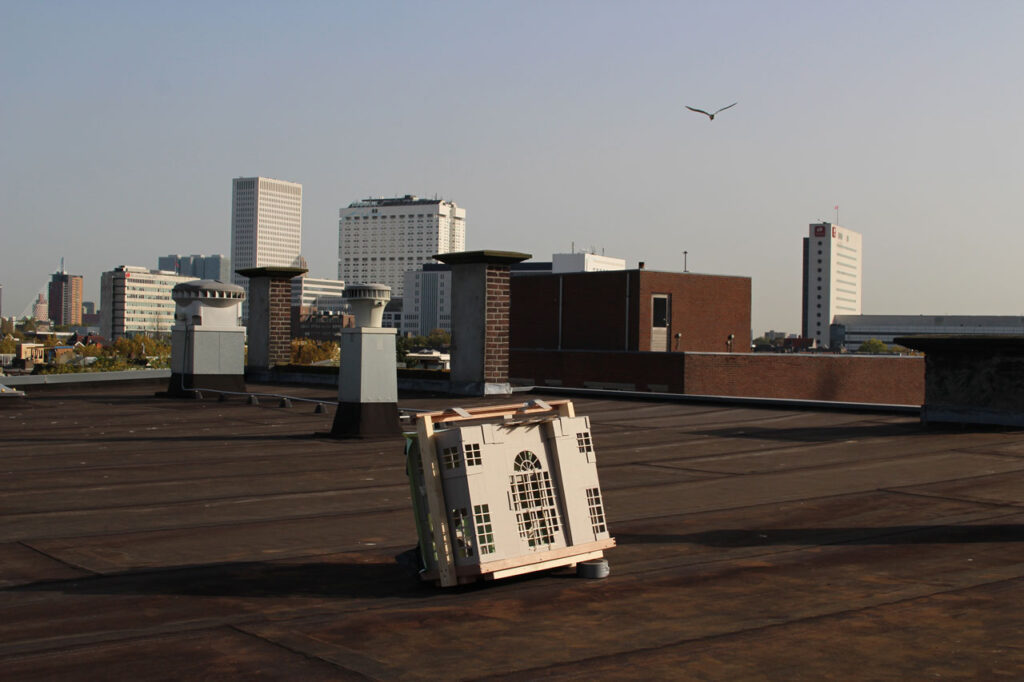
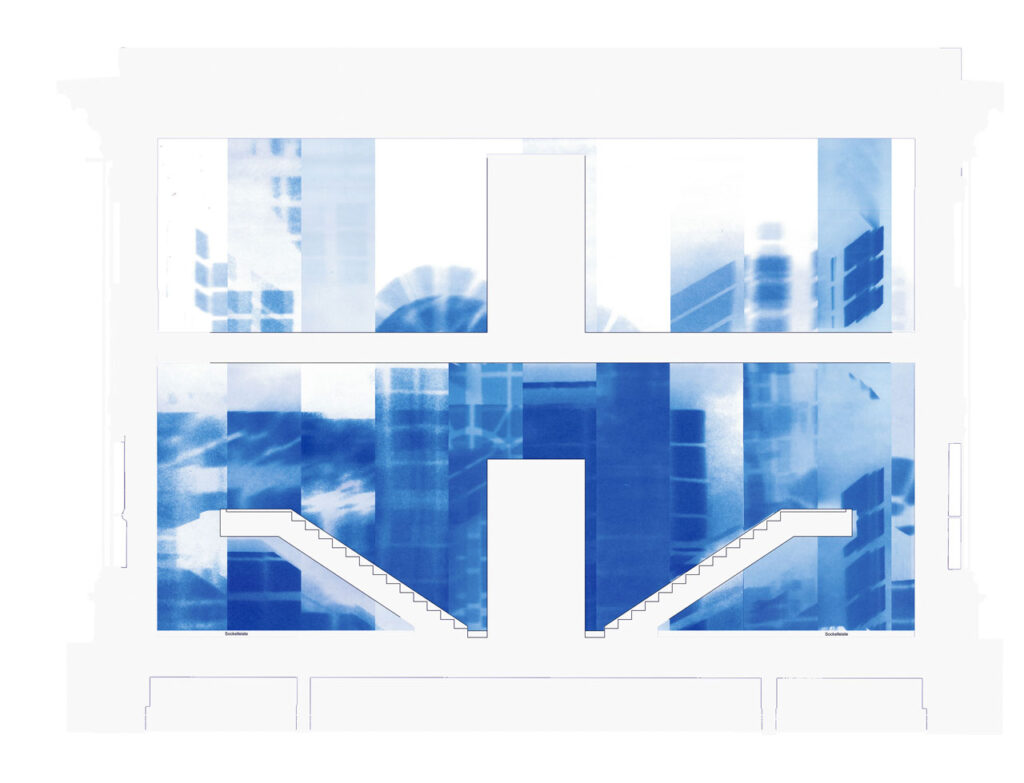
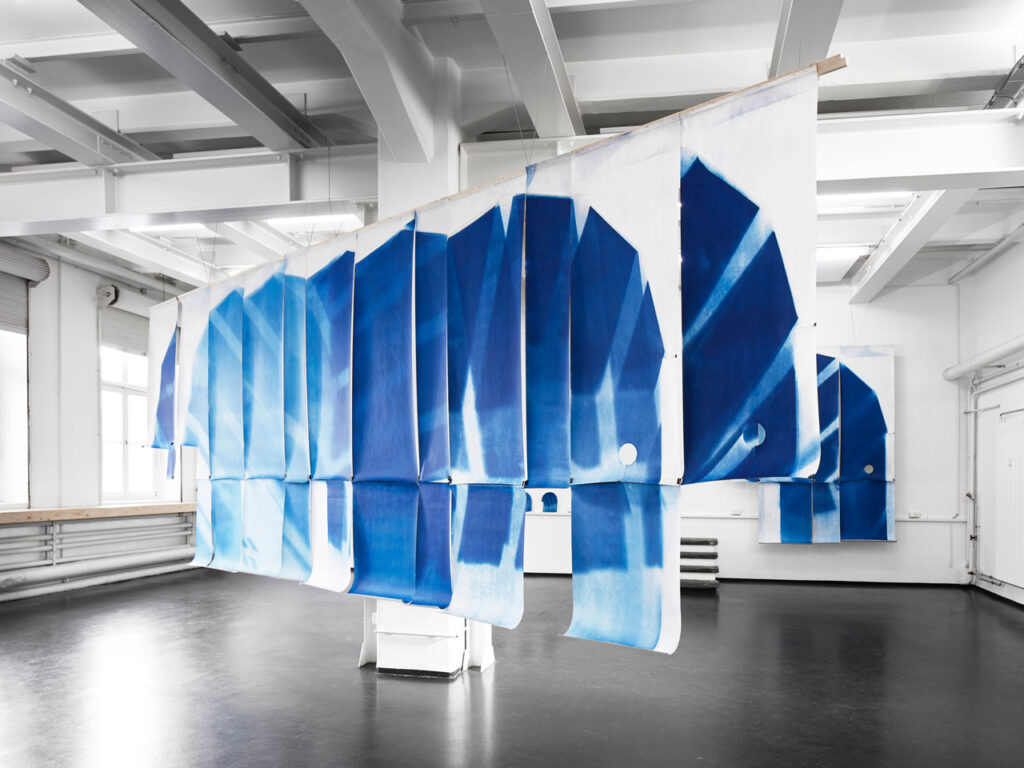
Lichtpause Model of part of the Humboldt Forum Berlin
Humboldt-Forum Berlin, 2017
Lichtpause
Collage cyanotype on paper.
Building: Humboldt-Forum Berlin. DE, 2017
Exposure Time: over the duration of 2 weeks, one exposure per day.
Under the same sun: a case study
Cyanotype on paper.
Sluice house Parkhaven Rotterdam. NL, 2018
Exposure Time: over the duration of 3 months, multiple exposures.
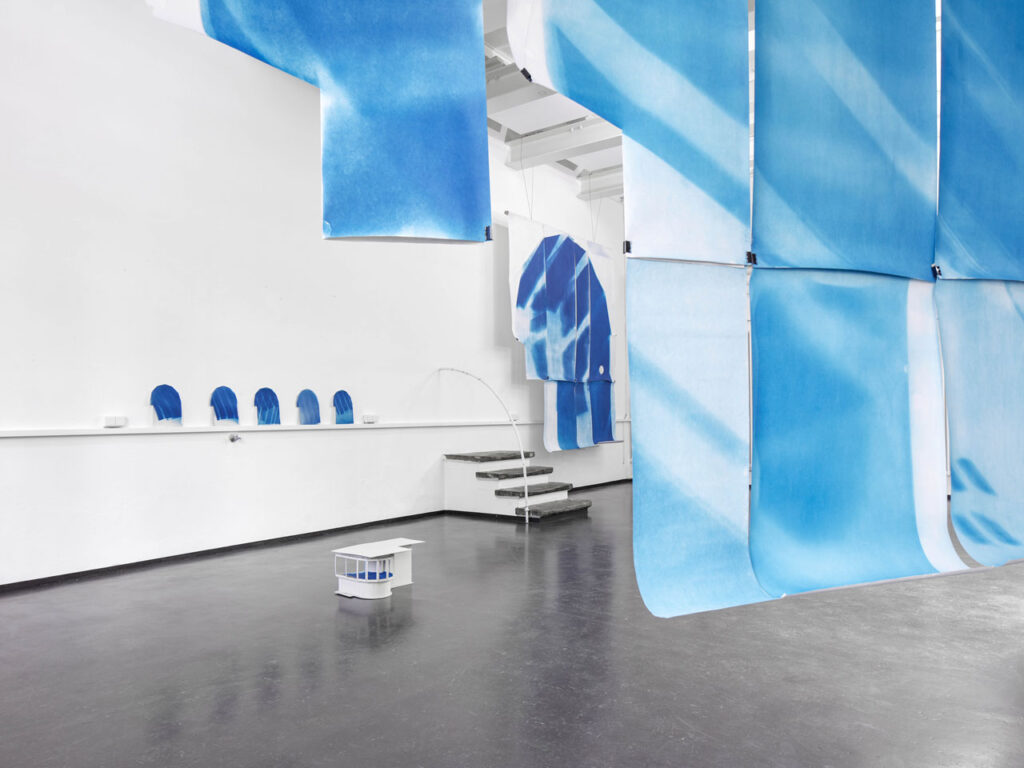
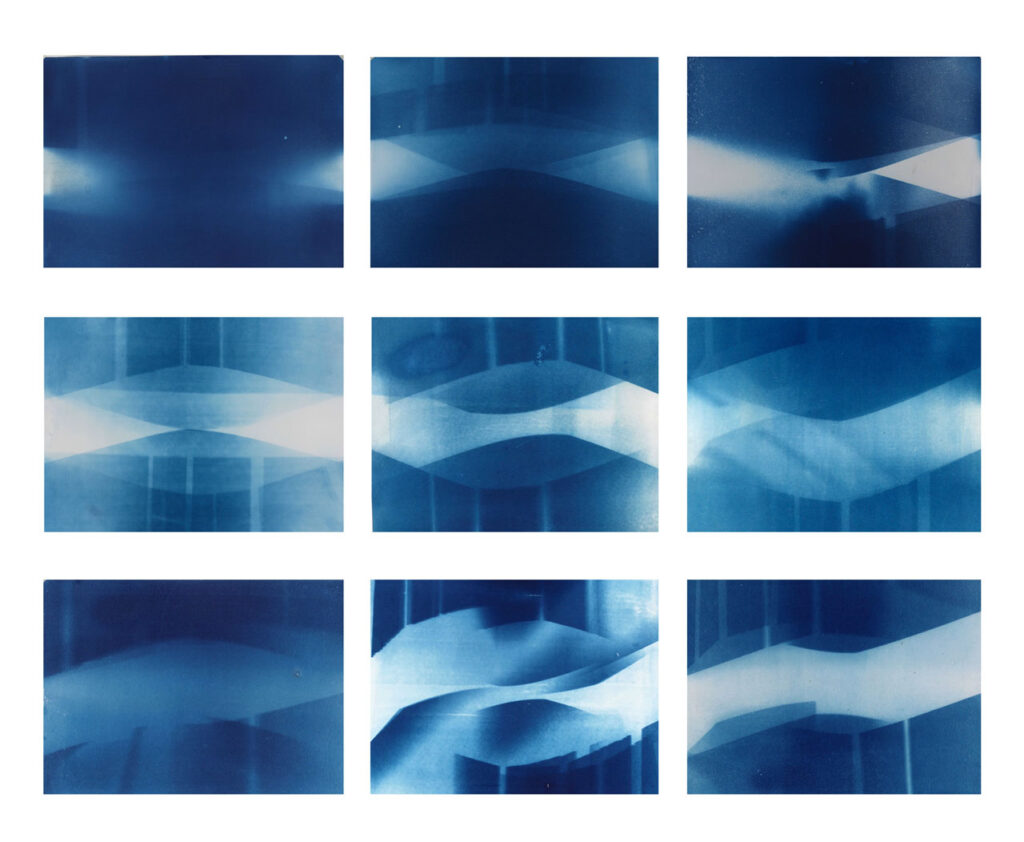
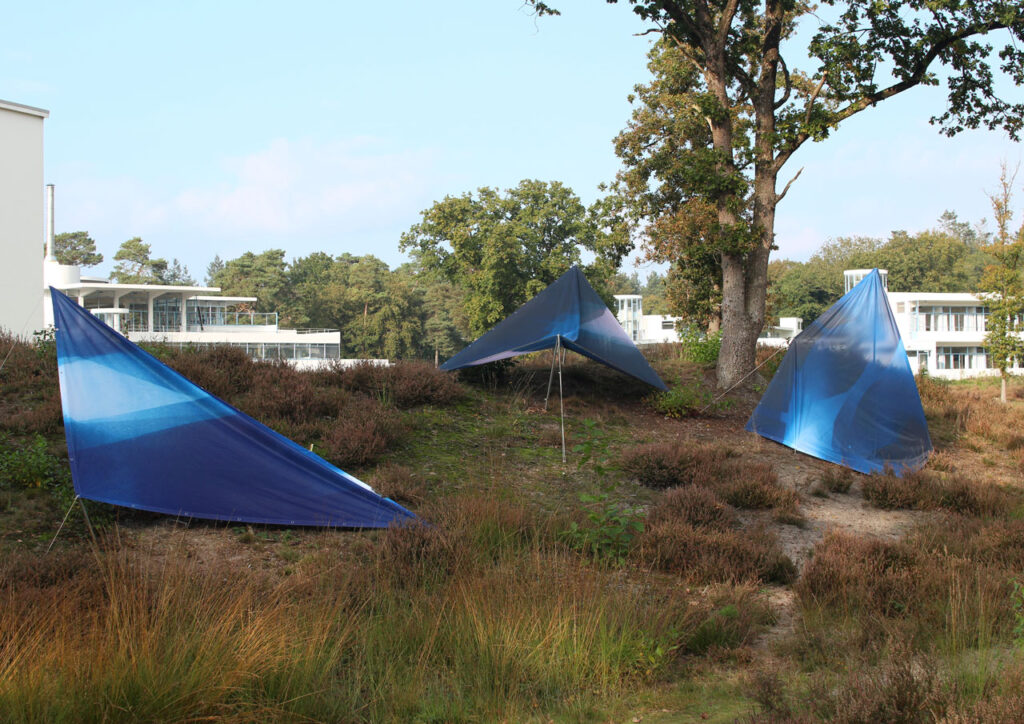
Under the same sun: a case study
Cyanotype on paper
Sluice house Parkhaven Rotterdam. NL, 2018
Exposure Time: over the duration of 3 months, multiple exposures.
Cutting someone else’s diamonds
Series of cyanotypes on paper
Sanatorium Zonnestraal Hilversum. NL, 2021
Exposure: 4 months, multiple exposures.
Cutting someone else’s diamonds
Prints on mesh
Sanatorium Zonnestraal Hilversum. NL, 2021
Exposure: 4 months, multiple exposures.
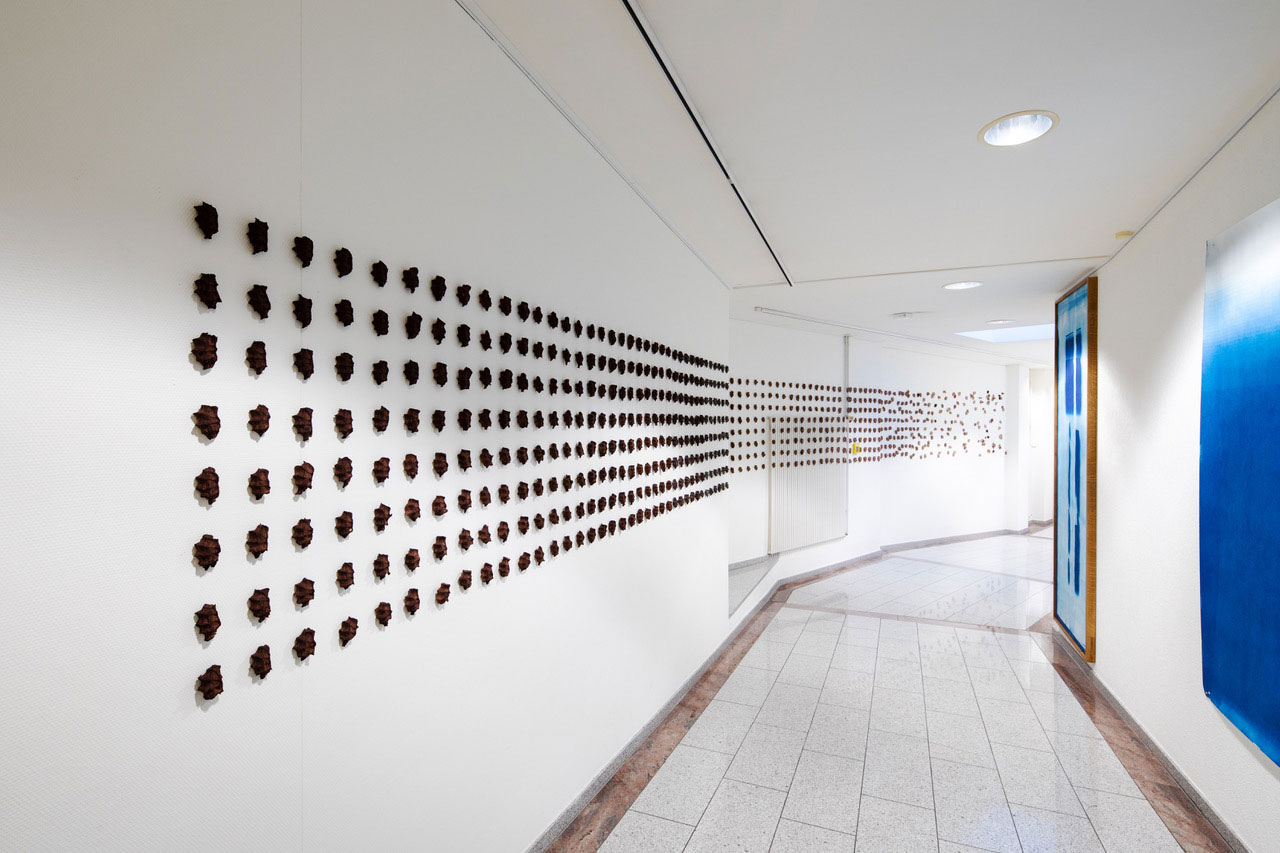
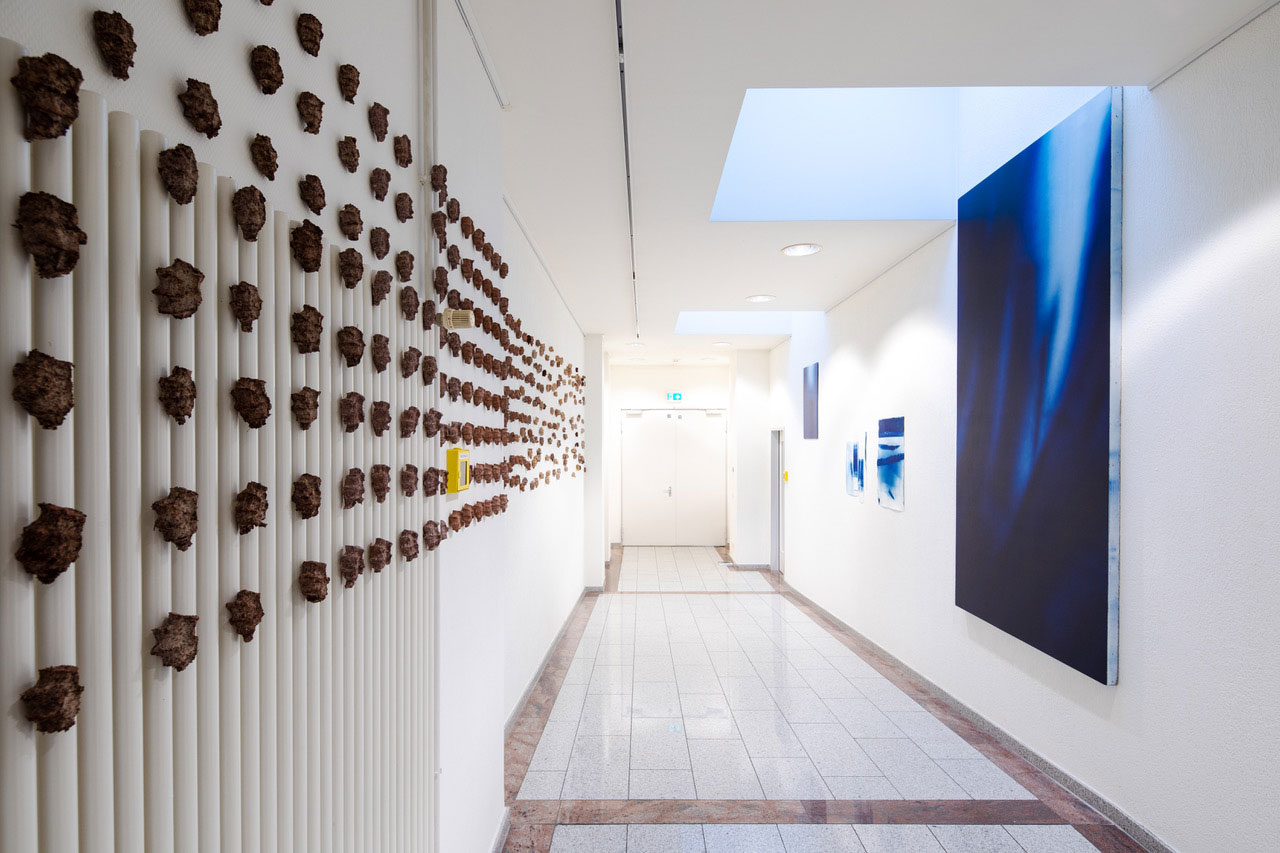
Exhibition view
Photos by Jacqueline Fuijkschot
Cutting someone else’s diamonds
Prints on mesh
Sanatorium Zonnestraal Hilversum. NL, 2021
Exposure: 4 months, multiple exposures.
Over Passages en passant
Passages en passant is een tijdelijke tentoonstellingsruimte in Rotterdam.
Passages en Passant strekt zich uit in het Goethe-Instituut Rotterdam in een gang die het entreegebied verbindt met de cafetaria. De doorgang heeft daklicht en is licht hellend, maar net als bij een tunnel zijn de tegenoverliggende muren zo dichtbij dat de ruimte die ze omarmen slechts een wandelgebied wordt. De blik van de voorbijganger, wanneer hij niet gefocust is op de openingen aan beide uiteinden, ontmoet de enorme muren links en rechts, die meestal geen observatie afdwingen.
Dit is waar Passages en passant graag rangschikt, test en overpeinst. In een omgeving die zeer vluchtig en praktisch is, worden kunstwerken uitgevoerd die geschikt zijn voor snel begrip en zich tegelijkertijd langzaam ontvouwen wanneer er in rust naar wordt gekeken.
In een reeks van zes tentoonstellingen wordt de gangruimte telkens ingevuld door werken van twee kunstenaars die inhoudelijk of positioneel reageren op de verschillende kwaliteiten van de ruimte en daarbij ook nieuwe relaties tussen de werken onderling voorstellen.
About Passages en passant
Passages en Passant is a temporary exhibition space in Rotterdam.
Passages en Passant stretches out in the Goethe-Institute Rotterdam in a hallway that connects the entrance area with the cafeteria. The passageway has roof lights and is slightly angled, but as with a tunnel, the opposing walls are so close that the space they embrace becomes a mere walking area. The passersby´s gaze, when not focussed on the openings at both ends, meets the huge walls to the left and right, which usually don´t compel observation.
This is where Passages en Passant likes to arrange, test and contemplate. In a setting that is highly transitory and practical, artworks are implemented that are fit for rapid comprehension and at the same time slowly unfold when being looked at with rest.
In a series of six exhibitions, with each the corridor space is rendered by the works of two invited artists that respond to the various qualities of the space’s content or by positioning, and thereby propose new relations among the works as well.
Over de mensen achter Passages en passant
Passages en Passant wordt gerund door Marco Douma en Kathrin Wolkowicz, beiden Rotterdamse kunstenaars die voortdurend een bijdrage willen leveren aan de levendige Rotterdamse kunstscene (en daarbuiten) met kunstwerken, het hosten en organiseren van evenementen en het cureren van tentoonstellingen.
Lees meer
Marco Douma is beeldend kunstenaar die zich richt op bewegend beeld en geluid. In zijn videowerk en video-installaties wordt de kijker meegevoerd naar een moment van contemplatie. Een moment om zich terug te trekken uit de hectiek van de dagelijkse realiteit en los te komen van triviale gedachten en beslommeringen. In zijn werk definieert hij de ondefinieerbare ruimte. De ruimte waar voorgrond en achtergrond in elkaar overvloeien.
Wat hem inspireert is de sensatie van vertragende bewegingen, ritme en kleuren in de (alledaagse) natuur en omgeving. Vaak dichtbij. Je ziet ze in een fractie van een seconde, een vertraagd beeld dat je gedachten even stilzet. Alsof de wereld even stilstaat. Hij vangt deze momenten en werkt ze uit. Hij wil de sensatie die hij ervaart benadrukken door het moment langer te laten duren en het om te zetten in vloeiende bewegingen. De vertraging werkt als een katalysator om je binnen enkele seconden uit je omgeving te verwijderen. Tijd en ruimte lossen op.
Het werk van Kathrin Wolkowicz strekt zich uit van performance, installatie, objecten en boeken tot film en video, en wordt meestal aangewakkerd door zelfgeschreven of aangepaste teksten. Het is een voorstel van op tijd gebaseerde of ruimtelijke situaties die uitnodigen tot het herlezen van iemands relatie met objecten en lichamen; hoe we verblijven, onze tijd doorbrengen en de ruimte delen met anderen.
Een belangrijk deel van Kathrin’s praktijk is collectief werken, als stichtend lid van Sils Projects, programmeur voor Suburban Video Lounge, onderdeel van 004-collective en Borgerstraat publicatie collectief. Voor een aantal van haar recente werken heeft ze de studio ingeruild voor de straat om met bewoners van door stadsontwikkeling getroffen gebieden een gemeenschappelijke basis te leggen.
Met ondersteuning van
Rutger Zuydervelt: ontwerp flyers en posters
Heleen Schröder: proeflezen Engels
Passages en Passant is run by Marco Douma and Kathrin Wolkowicz, both Rotterdam-based artists who continually like to contribute to Rotterdam´s vibrant art scene (and beyond) with art works, hosting and organizing events and curating exhibitions.
Read more
Marco Douma is a multidisciplinary / multimedia contemporary artist. He concentrates on (moving) image and sound, where time and space are dissolved, creating a moment of inner reflection and layers of meaning are subtly incorporated into images taken from daily life.
Marco is a member of the artist initiative Stichting B.a.d. in Rotterdam, with whom he develops national and international projects. He also frequently collaborates with Rutger Zuyderveld and Roel Meelkop in projects such as Pierdrie. He is also the founder of the multimedia agency Beeldhonger.
Kathrin Wolkowicz´s work spans from performance, installation, objects and books to film and video, and is usually kindled by self-written or adapted texts. It is a proposal of time-based or spatial situations that invite for re-reading one´s relationships with objects and bodies; how we dwell, spend our time and share the space with others.
A substantial part of Kathrin´s practice is working collectively, as founding member of Sils Projects, programmer for Suburban Video Lounge, part of 004-collective and Borgerstraat publication collective. For some of her recent works she has exchanged the studio for the street to lay out common grounds with inhabitants of areas affected by city development.
Kindly supported by
Rutger Zuydervelt: design flyers and posters
Heleen Schröder: proofreading English